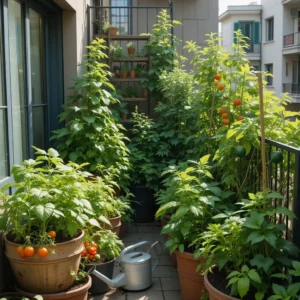Starting your journey to grow a beautiful prayer plant is exciting. These stunning indoor plants are loved by many in the United States. They are great for beginners because they are easy to care for.
Imagine having a thriving prayer plant at home. It will have vibrant leaves and stunning colors. To make this happen, you need to know the basics of caring for your plant. This includes choosing the right pot, soil, light, and water.
In this guide, you’ll learn everything to grow healthy prayer plants. It doesn’t matter if you’re new to plants or have experience. This guide will help you care for your indoor plants, including the prayer plant. It will ensure they thrive and add joy to your home.
Understanding the Prayer Plant: Origins and Characteristics
Exploring prayer plants means learning about their origins and traits. These plants come from the warm, humid areas of Central and South America. They are similar to Calathea plants in their love for warmth and moisture.
Prayer plants are known for their special ability. At night, their leaves fold up, looking like hands in prayer. This is one of the many interesting things about them.
Prayer plants come in over 100 different types. Some favorites include the Maranta leuconeura and the Calathea lancifolia. Each type has its own look, making them fun to grow and collect.
- Unique leaf patterns and colors
- Ability to fold leaves upwards at night
- Preference for warm and humid environments
- Diverse range of species, including Calathea and other tropical plants
Knowing these traits helps you care for your prayer plant better. This way, it can grow strong and healthy in its new home.
Choosing the Right Pot and Soil for Your Prayer Plant
Starting your prayer plant journey means picking the right pot and soil. The right mix is key for your houseplants to thrive. For prayer plants, a mix that drains well and is made for tropical plants is best.
Choosing the right pot size is important. It should give roots room to grow but not be too big. This prevents waterlogged soil and keeps your plant healthy. Good drainage helps prevent root rot and keeps your plant moist, making plant care easier.
Recommended Potting Mixes
- Look for a mix that contains a blend of peat moss, perlite, and vermiculite
- Avoid using regular potting soil, as it can compact and prevent proper drainage
- Consider adding a small amount of organic matter, such as compost, to enrich the soil
Pot Size and Drainage Considerations
Choose a pot that’s only a bit bigger than your plant’s current roots. This stops the soil from getting too wet and cuts down on root rot risk. Make sure the pot has holes for water to drain, keeping your prayer plant moist and healthy.
Light Requirements for Thriving Prayer Plants
Prayer plants are great for rooms with little natural light. They can grow well in low light. To keep your plant healthy, it needs the right light amount. East- or west-facing windows are best because they give indirect sunlight.
Prayer plants need the right light balance. Too much sun can hurt the leaves. Too little light makes them weak. Here are some tips:
- Place your prayer plant near an east- or west-facing window to provide indirect sunlight.
- Avoid placing your prayer plant in direct sunlight, especially during peak hours.
- Use sheer curtains or blinds to filter the sunlight and prevent scorching.
By following these tips, your prayer plant will thrive. Prayer plants can handle low light but still need some sun. With the right light, your plant will grow well and look great.
Watering Your Prayer Plant: Tips for Success
Watering your prayer plant right is key. Too much water can harm it, causing root rot and yellow leaves. Not enough water can make leaves dry and brown. To check if the soil is right, stick your finger in up to the first knuckle.
Water your prayer plant when the top inch of soil is dry. This can change based on your home’s humidity and temperature. For example, dry climates might mean more frequent watering for your indoor plants.
How Often to Water
- Water your prayer plant when the top inch of soil feels dry to the touch
- Check the soil moisture daily, especially during hot summer months
- Adjust your watering schedule according to the humidity and temperature of your environment

Identifying Overwatering and Underwatering
To keep your prayer plant healthy, watch for signs of too much or too little water. Yellow leaves or a soft stem mean too much water. Crispy, brown leaves suggest not enough water. By watching your plant and adjusting your watering, you can help it thrive.
Temperature and Humidity Needs for Prayer Plants
Exploring the world of prayer plants, like the stunning Calathea, reveals their unique needs. These tropical plants flourish in conditions that mirror their natural homes. To ensure your prayer plant thrives, focus on temperature and humidity.
The perfect temperature for prayer plants is between 65-75°F (18-24°C). This is a bit cooler than most rooms. It helps your Calathea photosynthesize well and keeps its colors bright. Also, the humidity should be between 50-70% for these tropical beauties.
Ideal Temperature Range
Keeping the right temperature is key for your prayer plant’s health. Don’t put your plant near heating or cooling vents, fireplaces, or drafty windows. These can cause big temperature swings. A stable temperature helps your plant grow well and stay stress-free.
Increasing Humidity Effectively
To boost humidity around your prayer plant, try a few easy methods. One way is to put the pot on a tray with water and pebbles. As the water evaporates, it raises the humidity. You can also use a humidifier, especially in dry places. The right humidity creates a great home for your tropical plants, including the lovely Calathea.
Here are some tips for the perfect environment for your prayer plant:
- Use a thermometer to monitor the temperature
- Place the plant on a tray with water and pebbles to increase humidity
- Avoid placing the plant near heating or cooling vents
Fertilizing Prayer Plants for Optimal Growth
As a houseplant lover, you know how key proper care is. This includes fertilizing your plants. Fertilizing your prayer plant is vital for it to grow well, especially when it’s actively growing. You can feed it once a month with a balanced, water-soluble fertilizer.
It’s important to dilute the fertilizer to half the recommended strength. This prevents the roots from getting burned. You can also use a fertilizer made for tropical plants. This will give your plant the nutrients it needs to grow healthily. By adding fertilization to your care routine, you’ll get to enjoy your prayer plant’s beauty and benefits.
Timing and Method of Fertilization
The timing and method of fertilizing are key in plant care. In spring and summer, your prayer plant needs more fertilizer, about once a month. In fall and winter, you can fertilize it every two months. Always follow the fertilizer package’s instructions and avoid over-fertilizing.
Recommended Fertilizer Types
Choosing the right fertilizer for your prayer plant can be tough. Balanced, water-soluble fertilizers and those made for tropical plants are popular. Look at the nutrient content and follow the instructions to ensure your plant grows well.

By following these tips and adding fertilization to your care routine, you’ll enjoy your prayer plant’s beauty and benefits. Always remember to prioritize proper plant care, including fertilization, to help your houseplants thrive.
Pruning and Propagating Prayer Plants
As you care for your prayer plant, focus on pruning and propagating. This keeps its shape and lets you share it. Pruning is key for removing dead leaves and promoting new growth, especially for low light plants.
When you prune, use clean, sharp tools to avoid spreading diseases. You can also share your foliage plants by dividing roots or using leaf cuttings. This is a wonderful way to spread the joy of your plants.
Effective Pruning Techniques
- Remove dead or damaged leaves to prevent the spread of disease
- Cut back long stems to encourage new growth and maintain shape
- Use clean and sharp tools to prevent spreading diseases
Methods for Successful Propagation
To propagate your prayer plant, divide the roots or use leaf cuttings. Use a well-draining potting mix and the right light and water. With care, your new low light plants will grow beautifully.
By following these tips, your prayer plant will stay healthy and vibrant. Always use clean tools and ensure your plants get enough light and water.
Common Pests and Diseases to Watch For
As a prayer plant owner, keeping your plants healthy is key. Knowing about common pests and diseases is important. Regular checks and good air flow can stop infestations.
Common pests include spider mites, mealybugs, and scale. To avoid these, check your plant often and ensure good air flow. If pests show up, use insecticidal soap or neem oil to treat them.
Identifying Common Pests
Spotting pests early is crucial. Here are some pests to watch for:
- Spider mites: These tiny pests can cause yellowing leaves and fine webbing on your plant.
- Mealybugs: These white, cottony pests can cause stunted growth and yellowing leaves.
- Scale: These armored pests can cause yellowing leaves and stunted growth.
Preventative Measures and Treatments
To prevent pests and diseases, do the following:
- Inspect your plant regularly
- Provide good air circulation
- Water your plant carefully to avoid overwatering
- Use insecticidal soap or neem oil to treat pests

By following these tips, you can keep your prayer plant healthy. Enjoy your indoor plants for years to come.
Troubleshooting Prayer Plant Issues
When you care for your Calathea, also known as a prayer plant, you might face some common problems. It’s important to find out what’s causing these issues. This way, you can fix them and help your tropical plants do well.
One common problem is yellowing leaves. This can happen if you water too much, too little, or if your plant gets too much direct sunlight. To solve this, check your watering and make sure your plant gets the right amount of indirect sunlight.
Yellowing Leaves: Causes and Solutions
- Check your watering schedule to ensure you’re not overwatering or underwatering your plant.
- Adjust the amount of direct sunlight your plant is receiving.
- Consider using a well-draining potting mix to prevent waterlogged soil.
Leaf Curling: What It Means
Leaf curling can mean your plant is thirsty, the air is too dry, or it’s getting too much sun. To fix this, raise the humidity, adjust your watering, and make sure it gets the right sunlight.
Seasonal Care Tips for Prayer Plants
As you care for your prayer plant, remember the seasons change. These changes can affect how you care for your plant. By adjusting your care, your prayer plant will thrive and look great in your home.
Houseplants like prayer plants need different care at different times. In spring and summer, they grow fast. They need more water and food to support their growth.

Adapting Care for Different Seasons
In fall and winter, your plant grows slower. You can water and fertilize it less often. This is a good time to make sure it has enough humidity and stays warm.
Preparing for Winter Care
To get your plant ready for winter, use a humidifier. Move it to a brighter spot to make up for the shorter days. These steps will help your plant stay healthy and beautiful all winter long.
| Season | Fertilization | Watering | Humidity |
|---|---|---|---|
| Spring/Summer | Frequent | Frequent | Medium |
| Fall/Winter | Less frequent | Less frequent | High |
Where to Buy Healthy Prayer Plants
Finding a healthy prayer plant for your home is important. You can buy one from local nurseries or online retailers.
Local Nurseries vs. Online Retailers
Shopping at local nurseries lets you see the plant before buying. Look for plants with green, lush leaves and strong stems. Stay away from plants with pests or diseases.
Online shopping is easy, but check the seller’s reputation and return policy first.
Evaluating Plant Health Before Purchase
Check the plant’s health whether you buy in person or online. Healthy plants have green leaves that fold up at night. This is a sign of their unique movement.
Also, inspect the soil and roots. The soil should be moist but not too wet. The roots should be white and firm, not brown and soft. With proper care, your prayer plant will flourish and enhance your space for years.




One thought on “Grow Vibrant Prayer Plants: A Guide for Beginners”